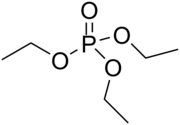Triethyl phosphate is an organic chemical compound with the formula (C2H5)3PO4 or OP(OEt)3. It is a colorless liquid. It is the triester of ethanol and phosphoric acid and can be called "phosphoric acid, triethyl ester".

| |

| |
| Names | |
|---|---|
| Preferred IUPAC name
Triethyl phosphate | |
| Other names
Phosphoric acid triethyl ester
Phosphoric ester (archaic) Flame retardant TEP[2] Tris(ethyl) phosphate Triethoxyphosphine oxide Ethyl phosphate (neutral) | |
| Identifiers | |
3D model (JSmol)
|
|
| Abbreviations | TEP, Et3PO4 |
| ChEBI | |
| ChemSpider | |
| DrugBank | |
| ECHA InfoCard | 100.001.013 |
PubChem CID
|
|
| UNII | |
CompTox Dashboard (EPA)
|
|
| |
| |
| Properties | |
| C6H15O4P | |
| Molar mass | 182.15 g/mol |
| Density | 1.072 g/cm3 |
| Melting point | −56.5 °C (−69.7 °F; 216.7 K) |
| Boiling point | 215 °C (419 °F; 488 K) |
| Miscible | |
| -125.3·10−6 cm3/mol | |
| Hazards | |
| NFPA 704 (fire diamond) | |
| Flash point | 107 °C (225 °F; 380 K) |
| Safety data sheet (SDS) | http://www.sciencelab.com/msds.php?msdsId=9925320 |
Except where otherwise noted, data are given for materials in their standard state (at 25 °C [77 °F], 100 kPa).
| |
Its primary uses are as an industrial catalyst (in acetic anhydride synthesis), a polymer resin modifier, and a plasticizer (e.g. for unsaturated polyesters). In smaller scale it is used as a solvent for e.g. cellulose acetate, flame retardant, an intermediate for pesticides and other chemicals, stabilizer for peroxides, a strength agent for rubber and plastic including vinyl polymers and unsaturated polyesters, etc.[3]
History
editIt was studied for the first time by French chemist Jean Louis Lassaigne in the early 19th century.
See also
editReferences
edit- ^ "Zhangjiagang Shunchang Chemical Co., Ltd". Triethylphosphate. Archived from the original on December 17, 2004. Retrieved June 13, 2009.
- ^ "Triethyl phosphate". pubchem.ncbi.nih.gov. Retrieved 2022-12-02.
- ^ Triethylphosphate, International Programme on Chemical Safety
